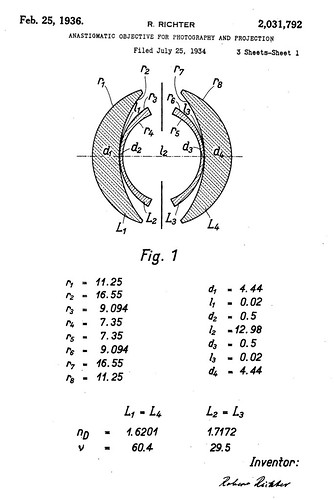Difference between revisions of "Topogon"
(Created page with "{{Flickr_image |image_source= http://www.flickr.com/photos/heritagefutures/6368541301/in/pool-camerawiki |image= http://farm7.staticflickr.com/6116/6368541301_5f8635d8aa.jpg |ima...") |
m |
||
| (2 intermediate revisions by 2 users not shown) | |||
| Line 1: | Line 1: | ||
{{Flickr_image | {{Flickr_image | ||
|image_source= http://www.flickr.com/photos/heritagefutures/6368541301/in/pool-camerawiki | |image_source= http://www.flickr.com/photos/heritagefutures/6368541301/in/pool-camerawiki | ||
| − | |image= http://farm7. | + | |image= http://farm7.static.flickr.com/6116/6368541301_5f8635d8aa.jpg |
|image_align= right | |image_align= right | ||
|image_text= Robert Richter Patent for the Topogon | |image_text= Robert Richter Patent for the Topogon | ||
| Line 8: | Line 8: | ||
}} | }} | ||
| − | The Topogon is an extra-wide field photographic lens of a double-Gauss design with an extremely curved meniscus to provide a 90° field of view. The lens is symmetrical front to back. The two outer positive elements are of high index crown glass while the two inner negative elements are of a high index flint glass. The lens was designed in 1933 by Robert Richter for [[Carl Zeiss]], Jena.<ref>[http://ip.com/patent/US2031792 US Patent US 2031792]</ref> | + | The '''Topogon''' is an extra-wide field photographic lens of a double-Gauss design with an extremely curved meniscus to provide a 90° field of view. The lens is symmetrical front to back. The two outer positive elements are of high index crown glass while the two inner negative elements are of a high index flint glass. The lens was designed in 1933 by Robert Richter for [[Carl Zeiss]], Jena.<ref>[http://ip.com/patent/US2031792 US Patent US 2031792]</ref> |
In the U.S.A. the lens was copied by [[Bausch & Lomb]] and sold as the [[Metrogon]], which found widespread use in [[Aerial camera | aerial cameras]]. | In the U.S.A. the lens was copied by [[Bausch & Lomb]] and sold as the [[Metrogon]], which found widespread use in [[Aerial camera | aerial cameras]]. | ||
| Line 15: | Line 15: | ||
== Notes == | == Notes == | ||
<references /> | <references /> | ||
| − | [[Category: | + | [[Category:German lenses]] |
[[Category: aerial cameras]] | [[Category: aerial cameras]] | ||
[[Category: Carl Zeiss|*]] | [[Category: Carl Zeiss|*]] | ||
Latest revision as of 09:29, 30 October 2013

|
| Robert Richter Patent for the Topogon image by Dirk HR Spennemann (Image rights) |
The Topogon is an extra-wide field photographic lens of a double-Gauss design with an extremely curved meniscus to provide a 90° field of view. The lens is symmetrical front to back. The two outer positive elements are of high index crown glass while the two inner negative elements are of a high index flint glass. The lens was designed in 1933 by Robert Richter for Carl Zeiss, Jena.[1] In the U.S.A. the lens was copied by Bausch & Lomb and sold as the Metrogon, which found widespread use in aerial cameras.